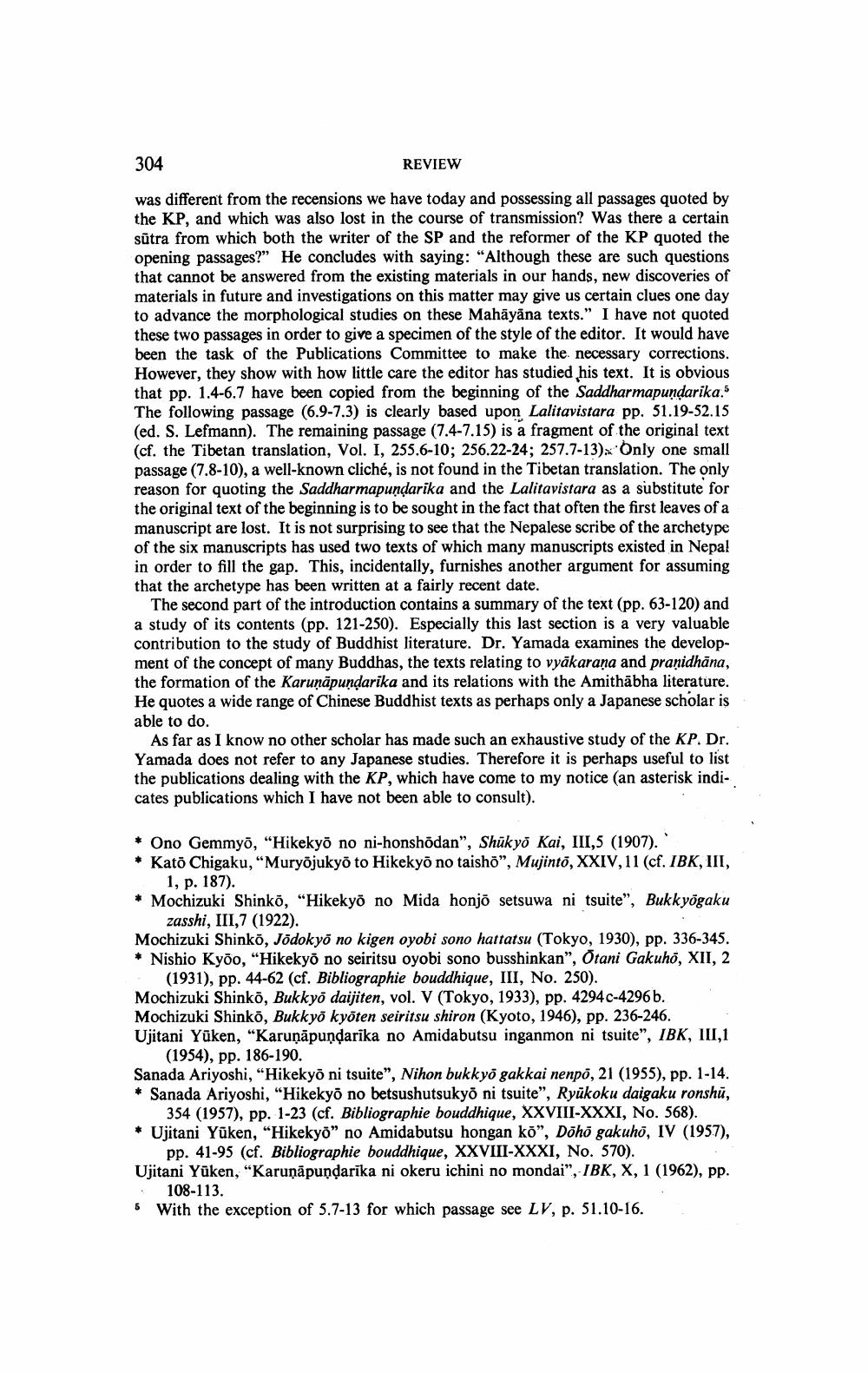Book Title: Reviews Of Different Books Author(s): Publisher: View full book textPage 8
________________ 304 REVIEW was different from the recensions we have today and possessing all passages quoted by the KP, and which was also lost in the course of transmission? Was there a certain sutra from which both the writer of the SP and the reformer of the KP quoted the opening passages?" He concludes with saying: "Although these are such questions that cannot be answered from the existing materials in our hands, new discoveries of materials in future and investigations on this matter may give us certain clues one day to advance the morphological studies on these Mahayana texts." I have not quoted these two passages in order to give a specimen of the style of the editor. It would have been the task of the Publications Committee to make the necessary corrections. However, they show with how little care the editor has studied his text. It is obvious that pp. 1.4-6.7 have been copied from the beginning of the Saddharmapundarika." The following passage (6.9-7.3) is clearly based upon Lalitavistara pp. 51.19-52.15 (ed. S. Lefmann). The remaining passage (7.4-7.15) is a fragment of the original text (cf. the Tibetan translation, Vol. I, 255.6-10; 256.22-24; 257.7-13). Only one small passage (7.8-10), a well-known cliche, is not found in the Tibetan translation. The only reason for quoting the Saddharmapundarika and the Lalitavistara as a substitute for the original text of the beginning is to be sought in the fact that often the first leaves of a manuscript are lost. It is not surprising to see that the Nepalese scribe of the archetype of the six manuscripts has used two texts of which many manuscripts existed in Nepal in order to fill the gap. This, incidentally, furnishes another argument for assuming that the archetype has been written at a fairly recent date. The second part of the introduction contains a summary of the text (pp. 63-120) and a study of its contents (pp. 121-250). Especially this last section is a very valuable contribution to the study of Buddhist literature. Dr. Yamada examines the development of the concept of many Buddhas, the texts relating to vyakarana and pranidhana, the formation of the Karunapundarika and its relations with the Amithabha literature. He quotes a wide range of Chinese Buddhist texts as perhaps only a Japanese scholar is able to do. As far as I know no other scholar has made such an exhaustive study of the KP. Dr. Yamada does not refer to any Japanese studies. Therefore it is perhaps useful to list the publications dealing with the KP, which have come to my notice (an asterisk indicates publications which I have not been able to consult). 50) * Ono Gemmyo, "Hikekyo no ni-honshodan", Shukyo Kai, III,5 (1907). * Kato Chigaku, "Muryojukyo to Hikekyo no taisho", Mujinto, XXIV, 11 (cf. IBK, III, 1, p. 187). * Mochizuki Shinko, "Hikekyo no Mida honjo setsuwa ni tsuite", Bukkyogaku zasshi, III, 7 (1922). Mochizuki Shinko, Jodokyo no kigen oyobi sono hattatsu (Tokyo, 1930), pp. 336-345. * Nishio Kyoo, "Hikekyo no seiritsu oyobi sono busshinkan", Otani Gakuho, XII, 2 (1931), pp. 44-62 (cf. Bibliographie bouddhique, III, No. 250). Mochizuki Shinko, Bukkyo daijiten, vol. V (Tokyo, 1933), pp. 4294c-4296 b. Mochizuki Shinko, Bukkyo kyoten seiritsu shiron (Kyoto, 1946), pp. 236-246. Ujitani Yuken, "Karunapundarika no Amidabutsu inganmon ni tsuite", IBK, III,1 (1954), pp. 186-190. Sanada Ariyoshi, "Hikekyo ni tsuite", Nihon bukkyo gakkai nenpo, 21 (1955), pp. 1-14. * Sanada Ariyoshi, "Hikekyo no betsushutsukyo ni tsuite", Ryukoku daigaku ronshu, 354 (1957), pp. 1-23 (cf. Bibliographie bouddhique, XXVIII-XXXI, No. 568). * jitani Yuken, "Hikekyo" no Amidabutsu hongan ko", Doho gakuho, IV (1957), pp. 41-95 (cf. Bibliographie bouddhique, XXVIII-XXXI, No. 570). Ujitani Yuken, "Karunapundarika ni okeru ichini no mondai", IBK, X, 1 (1962), pp. . 108-113. 5 With the exception of 5.7-13 for which passage see LV, p. 51.10-16.Page Navigation
1 ... 6 7 8 9 10 11 12 13 14 15 16 17 18 19 20 21 22 23
